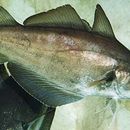Brief Summary
provided by Ecomare
Bibs are true bandits. With their feelers, they search for shrimp and crabs hiding in the bottom. They also go after small fish and shellfish. Young bibs live in large schools close to the coast. Older animals often swim between 10 and 300 meters deep, particularly above rocky bottoms and wrecks. Poor cod often swim along in the schools. Fishermen are not really interested in bib because the mellow meat spoils too quickly.
- license
- cc-by-nc
- copyright
- Copyright Ecomare
Diagnostic Description
provided by Fishbase
Chin barbel well developed. Pelvic fins with slightly elongated anterior rays. Body light brown dorsally, relatively tall, grayish on the sides becoming silvery ventrally, with four or five broad indistinct transverse bars on the sides; a dark blotch at the upper edge of the pectoral-fin base (Ref. 1371). Eye diameter as snout length. Anus lies below the middle of the first dorsal fin (Ref. 35388).
Life Cycle
provided by Fishbase
Oviparous, sexes are separate (Ref. 205).
Migration
provided by Fishbase
Oceanodromous. Migrating within oceans typically between spawning and different feeding areas, as tunas do. Migrations should be cyclical and predictable and cover more than 100 km.
Morphology
provided by Fishbase
Dorsal spines (total): 0; Analspines: 0
Biology
provided by Fishbase
Gregarious fish; immature ones often occur in large schools. Lives mostly on the outer shelf, but moves inshore to depths of 50 m or less for spawning. Feeds on benthic crustaceans but also on small fish, mollusks and polychaetes (Ref. 3663). Caught as a bycatch, used as food fish (Ref. 35388).
Importance
provided by Fishbase
fisheries: commercial; aquarium: public aquariums
Trisopterus luscus
provided by wikipedia EN
Trisopterus luscus (Latin pronunciation: [ˈtrisopterus ˈluskus]; bib, pout whiting, pout or most commonly pouting) is a seafish belonging to the cod family (Gadidae).
Distribution, size and life cycle
Pouting are found predominantly in European waters, especially around the south and west of the British Isles and in Scandinavian waters, although they can also be found in the Mediterranean and along the north African coast.[2] They can be found across rocky and sandy seabeds with smaller specimens being found close to the shore and larger pouting being moving further offshore. The greatest depths at which pouting can be found is 300 metres.[3] Pouting are generally a small fish, seldom exceeding 30 centimetres in length, although rare specimens can reach almost double this length. Pouting can reproduce before they reach two years of age and grow rapidly, reaching around 15 centimetres in length by the end of their first year. Pouting are a relatively short lived species, with the average lifespan thought to be around four years.[4]
Feeding and diet
Pouting are scavengers which feed on the seabed. They forage for any food source they can find with marine worms, shellfish and dead fish all making up their diet.[4] Due to their small size pouting are a source of prey for large species such as cod, bass and conger eels.
Commercial value
Pouting were previously ignored as a commercial fish, with pouting that were inadvertently caught by trawlers being either discarded at sea or processed into fishmeal.[4] Captured pouting are unlikely to survive when discarded.[5] However, the decline in the stocks of whitefish species such as cod and haddock has seen pouting acquire a growing value as a commercial fish,[4] and they are now available both as whole fish from fishmongers and supermarkets and are also used in fish products such as fish fingers and ready meals. Due to their naturally short lifespan and early breeding age pouting are seen as a relatively sustainable fish to eat.[6]
References
-
^ Di Natale, A.; Molinari, A.; Őztűrk, B. & Srour, A. (2011). "Trisopterus luscus". IUCN Red List of Threatened Species. 2011: e.T198587A9042469.
-
^ "Trisopterus luscus". FishBase. Retrieved 5 January 2017.
-
^ "Bib or Pouting, Trisopterus luscus". MarLIN - The Marine Life Information Network. Retrieved 5 January 2017.
-
^ a b c d "Pouting". British Sea Fishing. September 2012. Retrieved 5 January 2017.
-
^ Depestele, J.; Desender, M.; Benoît, H. P.; Polet, H.; Vincx, M. (2014). "Short-term survival of discarded target fish and non-target invertebrate species in the "eurocutter" beam trawl fishery of the southern North Sea". Fisheries Research. 154: 82–92. doi:10.1016/j.fishres.2014.01.018.
-
^ "Pouting or Bib". Good Fish Guide. Marine Conservation Society. Archived from the original on 14 July 2014. Retrieved 1 July 2014.

- license
- cc-by-sa-3.0
- copyright
- Wikipedia authors and editors
Trisopterus luscus: Brief Summary
provided by wikipedia EN
Trisopterus luscus (Latin pronunciation: [ˈtrisopterus ˈluskus]; bib, pout whiting, pout or most commonly pouting) is a seafish belonging to the cod family (Gadidae).
- license
- cc-by-sa-3.0
- copyright
- Wikipedia authors and editors

